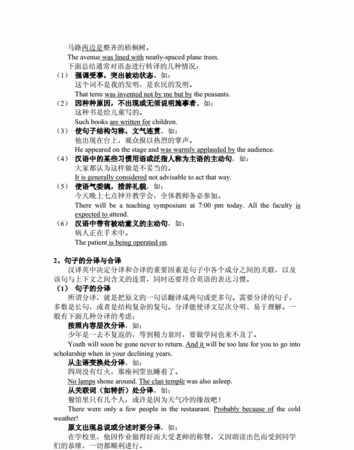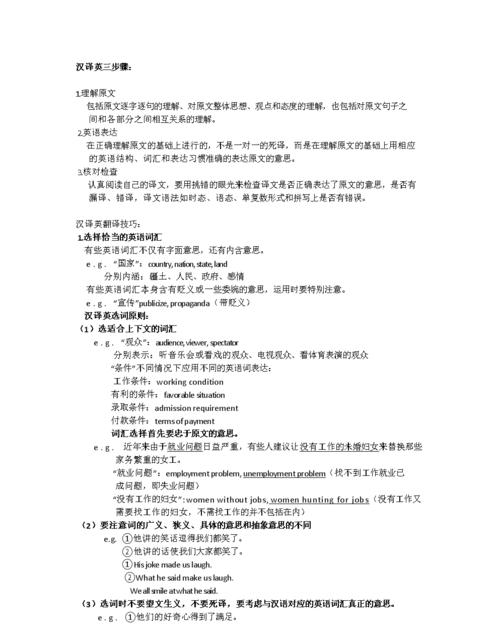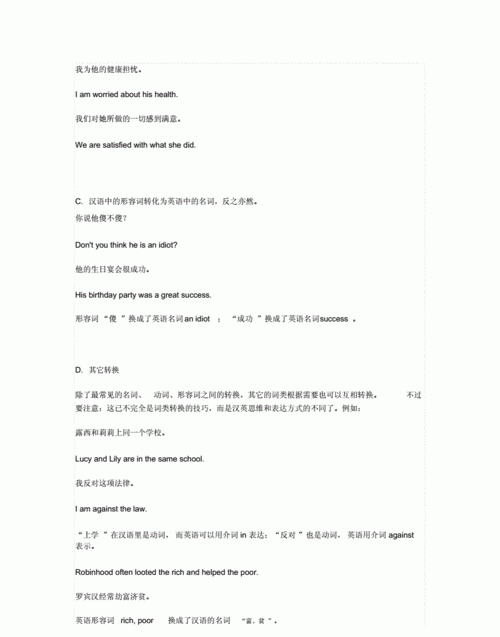谈到汉译英翻译技巧总结 是大家最关心的。有必要科普一下,英译汉翻译技巧和英语翻译有什么技巧汉译英翻译技巧总结 的内容,方便您深入了解英语句子翻译技巧和方法是什么,来了解了解。
汉译英翻译技巧总结 :翻译考试备考常用英汉翻译技巧有哪些
一、高屋建瓴“揽全局”。
主要是指翻译首先要分清英文主从句,一般先处理插入成分或从句,之后再处理主句。处理英文细节时要高屋建瓴、宏观把握,不拘泥于一字一词。行文需要注意中文特有的节奏感,不能拖沓冗长,要按照中文来龙去脉、由远及近的叙事原则组织行文。
二、行文提倡“四、六、八”。
主要是指英译中行文务求简洁、流畅、自然,而简洁的最佳办法就是采用四字句、六字句或八字句,增强行文张力时也是如此,采用四、六、八字句构成同义重复,这是中文的一大特点。如:口若悬河,剑拔弩张之势,箭在弦上不得不发。
三、中文“形散神不散”。
主要是指中文重意合,不像英文那样通过介词和连词串连成句,中文的逻辑散落在字里行间。在具体行文时遵循“以意群为成句单位”的原则,意群间除非确有必要,否则不用特别指明逻辑关系。
四、“九九归一”是王道。
主要是指英文中代词和其他替换同义词使用较为频繁,在英汉翻译时务必将英文中的代词所指列象明确化,同时将同义替换词或词组译为统一的汉语表达,保持前后一致。

汉译英翻译技巧总结 :翻译技巧是什么
英汉两种语言在句法、词汇、修辞等方面均存在着很大的差异,因此在进行英汉互译时必然会遇到很多困难,需要有一定的翻译技巧作指导。

常用的翻译技巧有增译法、省译法、转换法、拆句法、合并法、正译法、反译法、倒置法、包孕法、插入法、重组法和综合法等。
这些技巧不但可以运用于笔译之中,也可以运用于口译过程中,而且应该用得更加熟练,因为口译工作的特点决定了译员没有更多的时间进行思考。
1、增译法:指根据英汉两种语言不同的思维方式、语言习惯和表达方式,在翻译时增添一些词、短句或句子,以便更准确地表达出原文所包含的意义。
这种方式多半用在汉译英里。汉语无主句较多,而英语(论坛)句子一般都要有主语,所以在翻译汉语无主句的时候,除了少数可用英语无主句、被动语态或"There 。
be…"结构来翻译以外,一般都要根据语境补出主语,使句子完整。英汉两种语言在名词、代词、连词、介词和冠词的使用方法上也存在很大差别。
英语中代词使用频率较高,凡说到人的器官和归某人所有的或与某人有关的事物时,必须在前面加上物主代词。因此,在汉译英时需要增补物主代词,而在英译汉时又需要根据情况适当地删减。
英语词与词、词组与词组以及句子与句子的逻辑关系一般用连词来表示,而汉语则往往通过上下文和语序来表示这种关系。
因此,在汉译英时常常需要增补连词。英语句子离不开介词和冠词。另外,在汉译英时还要注意增补一些原文中暗含而没有明言的词语和一些概括性、注释性的词语,以确保译文意思的完整。总之,通过增译,一是保证译文语法结构的完整,二是保证译文意思的明确。
汉译英翻译技巧总结 :英译汉翻译技巧
英译汉翻译15种技巧
1. amplification
amplification for the purpose of rhetoric or coherence(修辞性或连贯性增
I came to a garden of grottoes, pavilions and shapely rocks and trees.
我来到一个假山花园前,园中亭阁玲珑,山石嶙峋,树木葱茏。
Amplification by repetition (重复性增词)
Avoid using this computer in extreme cold, heat, dust or humidity.
不要在过冷,过热,灰尘过重,湿度过大的情况下使用此电脑。
2. omission
omitting the pronoun
pronouns are more frequently used in English than in Chinese. Therefore , when translated into Chinese, many English pronouns may be omitted so as to conform the rendering to the accustomed usage of Chinese expression.
For two weeks, he had been studying the house, looking at its rooms, its electric wiring, its bath and its garden.
两周以来,他一直注意观察房子的情况,查看各个房间,留心电线的走向,通道和花园的布局。
Omitting the article
Any substance is made up of atoms whether it is a solid, a liquid, or a gas.
任何物质,不论是固体,液体还是气体, 都由原子组成。
3. division
Sometimes, an English sentence with a restrictive attributive clause is too long or too complicated for the translator to take as a single sentence. In this case, we may divide it into two or several parts, placing the attributive clause after the principle clause to conform to the Chinese usage, repeating the antecedent being modified.
Eg: They are striving for the ideal which is close to the heart of every Chinese and for which , in the past, many Chinese have laid down their lives。
他们正在为实现一个理想而努力,这个理想是每个中国人所珍爱的,在过去,许多中国人为了这个理想而牺牲了自己的生命。
He managed to raise a crop of 200 miracle tomatoes that weighed up to two pounds each.
他种出了200个大得惊人的西红柿,每个重达两磅。
4. combination( combination in restrictive attributive clauses)
Pollution is a pressing problem which we must deal with.
污染是我们必须解决的一个迫切问题。
The people who worked for him lived in mortal fear of him.
在他手下工作的人对他怕得要死。
5. extension
the extension of meaning may be either from the specific to the general or from the concrete to the abstract, and vice versa.
It is more than transient everydayness
.这远非一时的柴米油盐问题。(from the abstract to the concrete)
Americans love work, it is meat and drink to them
美国人热爱工作。对他们来说,工作就是乐趣。
6. substitution
the technique is used to replace the words of the original expression with Chinese synonyms or idioms according to different situations.
He was indeed a good riddance
他还是不在的好。
The same is not true with a mortal illness.

汉译英翻译技巧总结 :中译英有哪些实用翻译技巧
在中译英时,1.请注意中文的句式结构松散,而英文的句式由主题句和解释背景构成。(中英文句式重心不同)2. 中文多主动形式,英文常用被动形式。3.中文重动词,英文为静态语言,多用名词。所翻译题材若为政宣类,请查询固有术语,翻译以直译为佳,若为文学翻译,建议跳脱中文框架,意译更好

以上就是关于汉译英翻译技巧总结 ,英语句子翻译技巧和方法是什么的全部内容,以及汉译英翻译技巧总结 的相关内容,希望能够帮到您。
